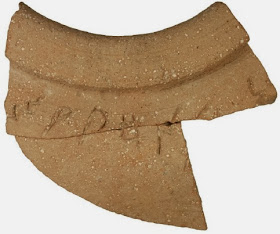An ancient eight-letter inscription — dating back to King Solomon’s reign in Jerusalem some 3,000 years ago — was deciphered by a researcher from the University of Haifa, shedding light on the Solomonic kingdom’s impressively sophisticated administrative system.Haaretz had details:
The carving was discovered on a clay jug in the Ophel area, near the southern wall of the Temple Mount, by a Hebrew University archaeological team headed by Dr. Eilat Mazar. It is considered the most ancient Hebrew engraving to emerge from the archaeological digs in Jerusalem to date.
However, the meaning of the cryptic inscription eluded researchers until Professor Gershon Galil of the University of Haifa interpreted it as a classification of a type of wine stored in the jug. He published his findings in the journal “New Studies on Jerusalem.”
Galil estimated that the carving was written in the middle of the tenth century BCE, after King Solomon built the First Temple, his palaces, and the surrounding walls that unified the three areas of the city — the Ophel area, the city of David, and the Temple Mount. These tremendous infrastructural projects contributed, Galil said, to the sudden need for copious quantities of poor-quality wine.
“This wine was not served on the table of King Solomon nor in the Temple,” Galil wrote. “Rather it was probably used by the many forced laborers in the building projects and the soldiers that guarded them. Food and drinks for these laborers were mainly held in the Ophel area.” His theory is shored up by pottery fragments found in Arad, Galil wrote.
Galil suggested that the letters were early Hebrew and identified the key word as "yayin", meaning wine.Here is Galil's illustration of the letters in the ancient Semitic alphabet:
Of all the region’s languages, Galil noted, only southern Hebrew wrote the word yayin with two instances of the letter yod, rather than one.
According to Galil’s interpretation, the inscription describes the wine that was in the jar bearing the inscription. The first letter is a final mem, which could be the end of the word "esrim" (twenty) or "shloshim" (thirty,) referring to either the twentieth or thirtieth year of Solomon’s reign. Next comes the word "yayin" (wine) followed by the word "halak", and then the letter mem, the first letter of the wine’s place of origin.
"Halak" is an oenological term from the Northern Syrian language of Ugarit. It referred to the lowest of three types of wine – “good wine,” “no good wine” and lowly "halak". Galil speculated that the poor-quality wine was drunk by the king's conscript labor force working on various building projects.
The three rightmost letters are partially conjecture on Galil's part; most of them fall outside the actual piece of pottery:
When you see that, then the "two yod" theory seems much less strong - those points could be part of other letters of the alphabet at the time.
The word "halak" (h-l-q) seems to be the best evidence for the missing letters to spell "yayin" but it is not a sure thing. This paper from July posits that the letters should actually be read right to left, and he also assumes that some letters are different than Galil's assumptions - for example, instead of h-l-q it might be h-p-q or h-l-r.
Still, Galil's hypothesis is interesting and any inscription in Jerusalem from First Temple times is spectacular.
(h/t DM)


